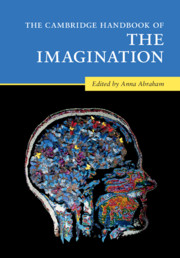Book contents
- The Cambridge Handbook of the Imagination
- The Cambridge Handbook of the Imagination
- Copyright page
- Dedication
- Contents
- Figures
- Contributors
- Acknowledgments
- 1 Surveying the Imagination Landscape
- Part I Theoretical Perspectives on the Imagination
- Part II Imagery-Based Forms of the Imagination
- Part III Intentionality-Based Forms of the Imagination
- Part IV Novel Combinatorial Forms of the Imagination
- 27 On the Interaction Between Episodic and Semantic Representations – Constructing a Unified Account of Imagination
- 28 How Imagination Supports Narrative Experiences for Textual, Audiovisual, and Interactive Narratives
- 29 Development of the Fantasy-Reality Distinction
- 30 Imagining the Real: Buddhist Paths to Wholeness in Tibet
- 31 Hypothetical Thinking
- 32 The Counterfactual Imagination: The Impact of Alternatives to Reality on Morality
- 33 A Look Back at Pioneering Theories of the Creative Brain
- Part V Phenomenology-Based Forms of the Imagination
- Part VI Altered States of the Imagination
- Name Index
- Subject Index
- References
31 - Hypothetical Thinking
from Part IV - Novel Combinatorial Forms of the Imagination
Published online by Cambridge University Press: 26 May 2020
- The Cambridge Handbook of the Imagination
- The Cambridge Handbook of the Imagination
- Copyright page
- Dedication
- Contents
- Figures
- Contributors
- Acknowledgments
- 1 Surveying the Imagination Landscape
- Part I Theoretical Perspectives on the Imagination
- Part II Imagery-Based Forms of the Imagination
- Part III Intentionality-Based Forms of the Imagination
- Part IV Novel Combinatorial Forms of the Imagination
- 27 On the Interaction Between Episodic and Semantic Representations – Constructing a Unified Account of Imagination
- 28 How Imagination Supports Narrative Experiences for Textual, Audiovisual, and Interactive Narratives
- 29 Development of the Fantasy-Reality Distinction
- 30 Imagining the Real: Buddhist Paths to Wholeness in Tibet
- 31 Hypothetical Thinking
- 32 The Counterfactual Imagination: The Impact of Alternatives to Reality on Morality
- 33 A Look Back at Pioneering Theories of the Creative Brain
- Part V Phenomenology-Based Forms of the Imagination
- Part VI Altered States of the Imagination
- Name Index
- Subject Index
- References
Summary
Hypothetical thinking involves imagining possibilities and mentally exploring their consequences. This chapter overviews a contemporary, integrative account of such thinking in the form of Jonathan Evans’s hypothetical thinking theory. This default-interventionist, dual–process theory operates according to three principles: relevance, singularity, and satisficing. To illustrate the explanatory strength of the theory a range of empirical evidence is considered that has arisen from extensive research on hypothesis testing, which involves individuals generating and evaluating hypotheses as they attempt to derive a more general understanding of information. The chapter shows how key findings from hypothesis-testing research undertaken in both laboratory and real-world studies (e.g. in domains such as scientific reasoning) are readily explained by the principles embedded in hypothetical thinking theory. The chapter additionally points to important new directions for future research on hypothetical thinking, including the need for: (1) further studies of real-world hypothesis testing in collaborative contexts, including ones outside of the domain of scientific reasoning; (2) increased neuroscientific analysis of the brain systems underpinning hypothetical thinking so as to inform theoretical developments; and (3) systematic individual-differences investigations to explore the likely association between people’s capacity to think creatively and their ability to engage in effective hypothetical thinking.
Keywords
- Type
- Chapter
- Information
- The Cambridge Handbook of the Imagination , pp. 514 - 528Publisher: Cambridge University PressPrint publication year: 2020
References
- 1
- Cited by



